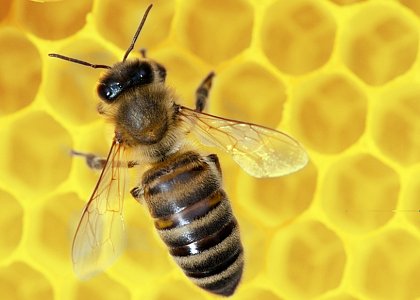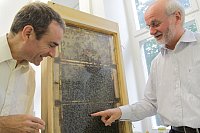Contact
Prof. Dr. Robin Moritz
phone: 0345 55 26223
robin.moritz@zoologie.uni-h...
Molekulare Ökologie, MLU
06099 Halle (Saale)
Prof. Dr. Robert Paxton
phone: 0345 55 23530
robert.paxton@zoologie.uni-...
Allgemeine Zoologie, MLU
06099 Halle (Saale)
Libyan honeybees cause a buzz
MLU post-grad discovers unknown subspecies that provides research material
SILVIO KISON
Dr. Taher Shaibi from Libya caused a media stir this summer. While carrying out research work in the Kufra Oasis in North Africa, he came across a subspecies of the Saharan honeybee undiscovered until then. He came as a post-graduate student to Halle from Libya and works at the Institute of Biology in the Zoology Department under Professor Robin Moritz, whose focus is on molecular ecology and, in particular, the honeybee. Shaibi’s discovery could bring about an international research project because these bees from the oasis are free of mites.

Honeybee on a comb. Foto: Heinz Waldukat / Fotolia
“Mr Shaibi originally came here to study the biology of the desert wood louse,” recalls Moritz. “However this proved to be of little success, so we came up with the idea of studying Libyan honeybees in Libya.” The deciding factor was less the connection to Libya than the main research focus of the Halle workgroup, which primarily studies the honeybee. Shaibi spent a lot of time searching for various regions in Libya and inventorying existing Libyan honeybees. “He had good access to remote regions such as the Kufra Oasis,” explains Moritz. The discovery of the subspecies of Saharan honeybee was less of a coincidence as it was a matter of luck. The unique thing isn’t how it looks, but rather the bio-geographical age of this exceptional bee population. Upon investigating its genes we found that this bee had already been in existence 10,000 years ago when the Sahara was not a desert but a steppe,” confirms the researcher. As time passed, this steppe slowly developed into a desert and the honeybees were forced to retreat. In the end, only the Kufra Oasis remained where they survived fully-isolated for thousands of years. This so-called relict population was able to develop without being impacted by mankind since the oasis in south-eastern Libya is more than 800 kilometres away from the cities on the Mediterranean. And the desert forms a nearly impenetrable barrier against other wild animals. “The wild honeybees were used by the inhabitants of the oasis as a source of honey but they didn’t breed them,” explains Moritz. The oasis is 40 km wide and offers enough space for the development of a healthy population.
Taher Shaibi returned to Libya after getting his PhD from the Martin Luther University. Yet his discovery still plays an important role for the subsequent research of Professor Moritz’ workgroup. The wild bees of the oasis are namely free of a parasite that has befallen a large proportion of their fellow species. This dangerous mite is known as Varroa destructor. The Kufra Oasis bees are one of only a handful of natural populations known today to not be afflicted by this parasite. “This is of particular interest to us, as we are currently on the brink of a new research project,” explains Moritz.

Prof. Robert Paxton and Prof. Robin Moritz talking about a bee colony in a so-called observation hive.
Photo: Silvio Kison
The research network BEE DOC (Bees in Europe and the Decline of Honeybee Colonies) is a conglomeration of scientists from eleven European countries that is coordinated by the institute in Halle. The scientists mainly examine the interactions between parasites, pathogens and pesticides in honeybees. The European Union has given three million euros worth of funding for the work of BEE DOC. The project began in March 2010 and will initially run three years. They will primarily study the effects in Europe. However this research has a global impact. “We have been watching entire bee colonies die out, not only in Europe, but around the world,” confirms Moritz.
Even though much has been done to prevent this, it is still unclear what is precisely causing this extinction. “We believe it’s the combination of parasites and pesticides,” says Moritz. The reasons behind this assumption lie in the US, where massive numbers of bees died in 2006 and 2007. The honeybee industry and the US government spent millions of dollars to get to the bottom of this sudden decline. “However so far no factors could be determined to be the cause of it,” explains Moritz. The scientists from BEE DOC therefore hypothesise that it must be a combination of factors that are causing the wide spread disappearance of bees. The already-mentioned Varroa mite is a classic example. It sucks at the honeybee, thereby transferring multiple viruses that are the cause of various diseases. Infected bees infect others in their colony which leads to an infestation of the entire population.
Just how this actually occurs and whether all of the viruses really stem from the mite is not yet fully understood. “This is why we are so interested in the wild bees in Kufra. Here we have a mite-free colony which can serve as a control population,” explains Moritz. The scientists now have the possibility of investigating whether the oasis bees are infested with parasites and if so, which ones. “If they have the same number of viruses as the European bees, then the mite does not have any impact on the bees’ dying. However if the bees are not infected with any, or only a few viruses, this could point to the mite being one of the culprits of the bees dying off.”
By networking with other European and North and South American projects, the findings will achieve a global visibility which will have a strong impact on species-appropriate beekeeping around the world. At the institute itself there are bee researchers with an international background. Since April 2010, Robert Paxton has been a professor there for general zoology. The 51 year-old is focusing on the evolutionary ecology of insects and, in particular, bees.
As mentioned in the 2/2010 edition of scientia halensis, one of his most important publications looks at the genetic analysis of “sweat bees”, which are a member of the halicitid bee family. According to Paxton “the bee displays a fantastic diversity in social behaviour.” Paxton also participated in a publication dealing with a fungal disease that affects honeybees that had spread around the world within a few years.
The biologist works closely together with professor Moritz. He brought his own research project on honeybees with him to Halle that carries out basic research on bees and insects. It is a partner programme of BEE DOC and is being funded by an English equivalent of the DFG. 1.5 million pounds have been earmarked for the project which will begin in October and also run three years. It will focus on investigating honeybee pathogens. “The research will mainly deal with honeybees and the parasites than infest them,” explains Paxton. Scientists are interested in finding out the impact an attack of two parasites has on the bee and how the parasites are transferred between different colonies.
Paxton is particularly interested in the interaction between honeybees and bumble bees, since these are more and more frequently being infected by pathogens that can also be found in bees. “The bumble bee,” according to Paxton, “alongside the bee, is one of the most important pollinators in Northern Europe and thus also worth keeping an eye on.”



